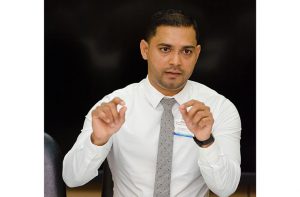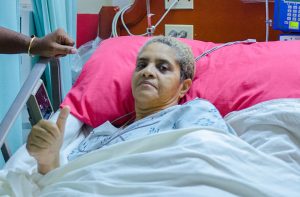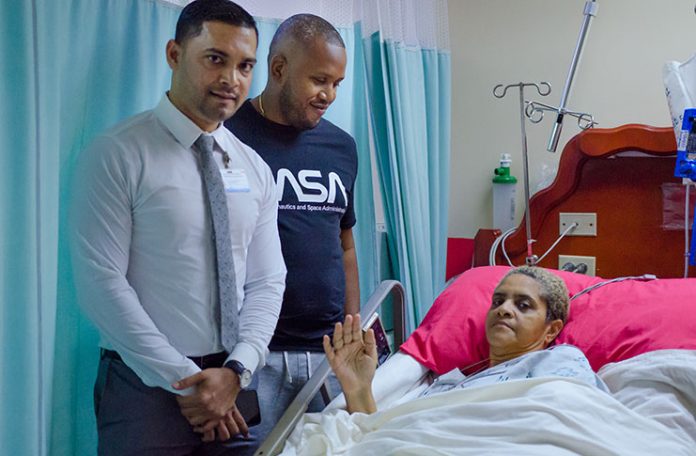Ground-breaking brain aneurysm surgery at GPHC offers advancements in neurological procedures
– First world medical treatment done locally for a fraction of the cost
NEUROSURGEON Dr. Amarnauth Dukhi has successfully pioneered an endovascular brain aneurysm surgery in Guyana with the use of cutting-edge technology that minimises neurological risk and reduced recovery time.
The surgery was performed on Wednesday last at the Caribbean Heart Institute (CHI), located at the Georgetown Public Hospital Corporation (GPHC). The surgery was performed using a minimally invasive technique that does not involve opening the skull and can get to the aneurysm without even touching the brain.
Speaking to the media on Friday at a press conference at the GPHC Administration Building, Dr. Dukhi, who heads the Neurosurgery Department, explained that an aneurysm is a weakened spot in a blood vessel wall and if the aneurysm enlarges or ruptures it can cause bleeding in the brain called subarachnoid hemorrhage (SAH), a life-threatening type of stroke. “For neurosurgeons, it is what we call a ticking time bomb. If it ruptures or when it does rupture, 40 per cent of our patients die; 15 per cent of which before they actually reach the hospital for the first rupture, while 60 per cent of the patients who survive have some sort of neurological deficit”.

He related that the patient, Paula Sampson 56, of Georgetown is recovering positively despite suffering a rupture six weeks ago which was treated conservatively and resolved. However, Sampson unfortunately developed a second bleed. The Neurosurgeon highlighted that in cases of the second bleed from a brain aneurysm, 78-80 per cent of patients die.
“For this particular patient she made it through the second bleed, through conservative management and pre-care because she could not have been medevac out of Guyana because of her condition”.
Through the support of GPHC, CHI and the Ministry of Public Heath, Dr Dukhi was able to bring international renowned radiologist, Dr Tharois Yorkis, who assisted the team. In explaining how the procedure is done, Dr Dukhi said during endovascular coiling, a catheter is passed through the thigh area through the femoral artery and then guided through the heart and other vessels into the artery containing the aneurysm, the coil in released thereby blocking blood flow to the aneurysm.
“This entails getting to the aneurysm, localising it and coiling it which simply means placing a metallic structure that coils the defect”.
He explained, during the procedure a closed vessel was discovered in the brain, as such a stent needed to be placed. The overall surgical procedure lasted for two and a half hours. Generally a surgery of this nature would cost in the region of US$200,000 but was done locally for a fraction of the cost.
Meanwhile, he noted one of the challenges faced in treating a brain aneurysm in a less invasive way is access to the equipment since it is quite expensive. A procedure of this nature being offered in Guyana paves the way for advancements in neurological procedures done on local shores which ultimately reduces the risk of a stroke and fatality in patients.
He noted also, the other method of treating an aneurysm through surgical intervention involves opening and taking out piece of the skull, getting to the bottom of the brain and putting a metal clip on the aneurysm. This procedure is extremely risky as it entails the possibility of rupture during surgery.
Currently, first world countries have moved towards the minimally invasive treatment which has fewer complications. “This is something fantastic for our country simply because we are on par with what’s happening internationally. We may be the third country in the Caribbean doing this other than Trinidad and Jamaica and we want to say we have successfully treated the first brain aneurysm in Guyana”.

Dr. Dukhi has expressed gratitude to the Ministry of Public Health for lending support to this new development in the health sector, even as he stressed the danger of a potential rupture. “We are happy to announce another new development nationally and we would like to look forward to patients with brain aneurysm that they no longer have to be medevac out of Guyana. We have created a partnership with Dr. Thoris and he is willing to come when the need arises”.
Meanwhile, Medical Director of the GPHC, Dr. Fawcett Jeffery, commended the advancements made by the local surgeon and the team of specialists. He said it is testimony to the strides made at the premier public institution. “This is fantastic. This is the way to go for minimally invasive surgery at the highest level and we have that in Guyana. We can continue raising the bar for medical attention. It is something over the years we have seen progression, we started off doing little things and we have so many different specialties doing fantastic jobs for the Guyanese population and this is just one of the many examples of what happens in this institution.”
When the Guyana Chronicle visited Ms. Sampson she was in high spirits as she exchanged greetings in the recovery room, she anticipated being discharged today (Saturday). Dr. Dukhi posited the patient is expected to recover fully and will be able to move forward leading a normal life.
In March 2018, Dr. Dukhi created history in Guyana by becoming the first country in South America to perform, successfully, a Vault C Anterior Discectomy and Fusion System (ACDF) implant surgery restoring motor functions to two patients who were partially paralysed. Overtime he has spearheaded major advancements in neurosurgery locally, placing Guyana on the forefront of leading medical treatment.

